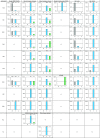Evidence for multi-copy Mega-NUMTs in the human genome
- PMID: 33450006
- PMCID: PMC7897518
- DOI: 10.1093/nar/gkaa1271
Evidence for multi-copy Mega-NUMTs in the human genome
Abstract
The maternal mode of mitochondrial DNA (mtDNA) inheritance is central to human genetics. Recently, evidence for bi-parental inheritance of mtDNA was claimed for individuals of three pedigrees that suffered mitochondrial disorders. We sequenced mtDNA using both direct Sanger and Massively Parallel Sequencing in several tissues of eleven maternally related and other affiliated healthy individuals of a family pedigree and observed mixed mitotypes in eight individuals. Cells without nuclear DNA, i.e. thrombocytes and hair shafts, only showed the mitotype of haplogroup (hg) V. Skin biopsies were prepared to generate ρ° cells void of mtDNA, sequencing of which resulted in a hg U4c1 mitotype. The position of the Mega-NUMT sequence was determined by fluorescence in situ hybridization and two different quantitative PCR assays were used to determine the number of contributing mtDNA copies. Thus, evidence for the presence of repetitive, full mitogenome Mega-NUMTs matching haplogroup U4c1 in various tissues of eight maternally related individuals was provided. Multi-copy Mega-NUMTs mimic mixtures of mtDNA that cannot be experimentally avoided and thus may appear in diverse fields of mtDNA research and diagnostics. We demonstrate that hair shaft mtDNA sequencing provides a simple but reliable approach to exclude NUMTs as source of misleading results.
© The Author(s) 2021. Published by Oxford University Press on behalf of Nucleic Acids Research.
Figures




Similar articles
-
Interpreting NUMTs in forensic genetics: Seeing the forest for the trees.Forensic Sci Int Genet. 2021 Jul;53:102497. doi: 10.1016/j.fsigen.2021.102497. Epub 2021 Mar 15. Forensic Sci Int Genet. 2021. PMID: 33740708 Review.
-
Mitochondrial pseudogenes in the nuclear genome of Aedes aegypti mosquitoes: implications for past and future population genetic studies.BMC Genet. 2009 Mar 6;10:11. doi: 10.1186/1471-2156-10-11. BMC Genet. 2009. PMID: 19267896 Free PMC article.
-
The Mighty NUMT: Mitochondrial DNA Flexing Its Code in the Nuclear Genome.Biomolecules. 2023 Apr 27;13(5):753. doi: 10.3390/biom13050753. Biomolecules. 2023. PMID: 37238623 Free PMC article. Review.
-
Specificity of mtDNA-directed PCR-influence of NUclear MTDNA insertion (NUMT) contamination in routine samples and techniques.Int J Legal Med. 2008 Jul;122(4):341-5. doi: 10.1007/s00414-007-0191-5. Epub 2007 Sep 14. Int J Legal Med. 2008. PMID: 17874117
-
Nuclear-mitochondrial DNA segments resemble paternally inherited mitochondrial DNA in humans.Nat Commun. 2020 Apr 8;11(1):1740. doi: 10.1038/s41467-020-15336-3. Nat Commun. 2020. PMID: 32269217 Free PMC article.
Cited by
-
mtDNA Heteroplasmy: Origin, Detection, Significance, and Evolutionary Consequences.Life (Basel). 2021 Jun 29;11(7):633. doi: 10.3390/life11070633. Life (Basel). 2021. PMID: 34209862 Free PMC article. Review.
-
Mitochondrial genome plasticity of mammalian species.BMC Genomics. 2024 Mar 14;25(1):278. doi: 10.1186/s12864-024-10201-9. BMC Genomics. 2024. PMID: 38486136 Free PMC article.
-
NUMTs Can Imitate Biparental Transmission of mtDNA-A Case in Drosophila melanogaster.Genes (Basel). 2022 Jun 6;13(6):1023. doi: 10.3390/genes13061023. Genes (Basel). 2022. PMID: 35741785 Free PMC article.
-
Somatic nuclear mitochondrial DNA insertions are prevalent in the human brain and accumulate over time in fibroblasts.PLoS Biol. 2024 Aug 22;22(8):e3002723. doi: 10.1371/journal.pbio.3002723. eCollection 2024 Aug. PLoS Biol. 2024. PMID: 39172952 Free PMC article.
-
The Value of Whole-Genome Sequencing for Mitochondrial DNA Population Studies: Strategies and Criteria for Extracting High-Quality Mitogenome Haplotypes.Int J Mol Sci. 2022 Feb 17;23(4):2244. doi: 10.3390/ijms23042244. Int J Mol Sci. 2022. PMID: 35216360 Free PMC article.
References
-
- Hutchison C.A., Newbold J.B., Potter S.S., Edgell M.H.. Maternal inheritance of mammalian mitochondrial DNA. Nature. 1974; 251:536–538. - PubMed
-
- Passamonti M., Ghiselli F.. Doubly uniparental inheritance: two mitochondrial genomes, one precious model for organelle DNA inheritance and evolution. DNA Cell Biol. 2009; 28:79–89. - PubMed
-
- Cann R.L., Stoneking M., Wilson A.C.. Mitochondrial DNA and human evolution. Nature. 1987; 325:31–36. - PubMed
Publication types
MeSH terms
Substances
Grants and funding
LinkOut - more resources
Full Text Sources
Other Literature Sources

